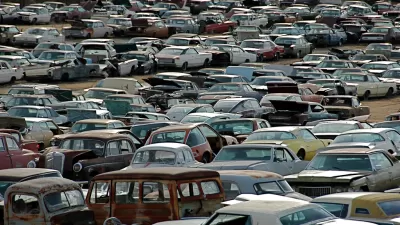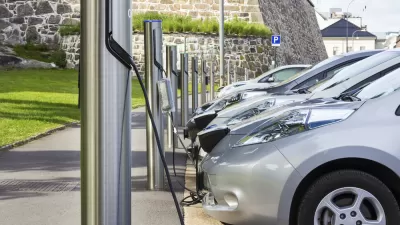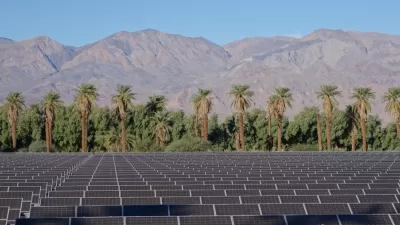The California Air Resources Board voted unanimously on August 25 to begin a phased ban on the sale of passenger vehicles powered by gasoline or diesel beginning in 2026 when over a third of new vehicles sold in California must be zero-emissions.

“The new policy, detailed Wednesday morning in a news conference, is widely expected to accelerate the global transition toward electric vehicles,” reported Coral Davenport, Lisa Friedman and Brad Plumer for The New York Times on August 24.
“The rule establishes a year-by-year roadmap so that by 2035, 100% of new cars and light trucks sold in California will be zero-emission vehicles, including plug-in hybrid electric vehicles,” states the August 25 press release by the California Air Resources Board (CARB), regulators charged with improving the state's worst-in-the-nation air quality and adopting regulations to meet the state's rigorous greenhouse gas reduction standards.
The regulation realizes and codifies the light-duty vehicle goals set out in Governor Newsom’s Executive Order N-79-20.
[Related post: Gone by 2035: Gas-Powered Car Sales Have an Expiration Date in California, September 24, 2020]
What Happens in California Doesn't Stay There
“Not only is California the largest auto market in the United States, but more than a dozen other states typically follow California’s lead when setting their own auto emissions standards,” add Davenport, Friedman and Plumer.
Known as Section 177 states for that section of the U.S. Clean Air Act that deals with tailpipe emissions, all but two of the fifteen states can adopt California's Zero-Emission Vehicle Program. [See related tag.]
If those states follow through, and most are expected to adopt similar rules, the restrictions would apply to about a third of the United States auto market.
“This is huge,” said Margo Oge, an electric vehicles expert who headed the Environmental Protection Agency’s transportation emissions program under Presidents Bill Clinton, George W. Bush and Barack Obama. As additional states put in place their own versions of these policies, “they will drive the market, and drive innovation,” she said.
Power Grid Challenge Ahead
Appearing on CNN on Saturday morning, anchor Amara Walker asked Oge:
“I'm sure you are hearing...from experts who say California's infrastructure is not prepared to handle an influx of electric cars, especially with an electric grid already strained by record heat. What about significant investments of the grid infrastructure, because you're going to have now millions of battery electric or even fuel cell electric vehicles on the roads?”
Oge acknowledged the existing strain which has caused Gov. Newsom to consider extending the life of the state's sole remaining nuclear powered plant that had been slated to close in 2025 and four older natural gas-powered plants.
“What I'm hearing from the experts, it's not as much as how many electric cars will be charged on a daily basis but rather what time of the day those charges will take place,” replied Oge.
"For example, I live in Los Angeles, and Southern California Edison was giving me a great rate if I charged my car at any time of the day except from 4:00 to 9:00. So for me it's like the equivalent of spending $2 for gasoline..."
[Average price of gasoline in California on Aug. 28: $5.28 per gallon.]
What About Enforcement?
What if auto consumers don't cooperate? Friedman and Plumer of the Times wrote on Aug. 26 that the plan sets "strict limits on what automakers can and can’t sell. Failure to meet those targets carries the threat of stiff penalties."
Targets, per CARB: "The new regulation accelerates requirements that automakers deliver an increasing number of zero-emission light-duty vehicles each year beginning in model year 2026. Sales of new ZEVs and PHEVs will start with 35% that year, build to 68% in 2030, and reach 100% in 2035."
"If automakers fail to comply, they will face a $20,000 fine for each new vehicle sold in violation of the targets," add Friedman and Plumer.
Since that amount far exceeds the profit margin of the typical passenger vehicle, it is unlikely that companies would choose to pay the penalty, experts said.
“California is good at enforcing its rules,” said Dan Becker, director of the Safe Climate Transport Campaign at the Center for Biological Diversity. “Companies at their peril violate those rules.”
Related:
FULL STORY: California to Ban the Sale of New Gasoline Cars

Study: Maui’s Plan to Convert Vacation Rentals to Long-Term Housing Could Cause Nearly $1 Billion Economic Loss
The plan would reduce visitor accommodation by 25,% resulting in 1,900 jobs lost.

North Texas Transit Leaders Tout Benefits of TOD for Growing Region
At a summit focused on transit-oriented development, policymakers discussed how North Texas’ expanded light rail system can serve as a tool for economic growth.

Using Old Oil and Gas Wells for Green Energy Storage
Penn State researchers have found that repurposing abandoned oil and gas wells for geothermal-assisted compressed-air energy storage can boost efficiency, reduce environmental risks, and support clean energy and job transitions.

Planting Relief: Tackling Las Vegas Heat One Tree at a Time
Nevada Plants, a Las Vegas-based nonprofit, is combating the city’s extreme urban heat by giving away trees to residents in underserved neighborhoods, promoting shade, sustainability, and community health.

How Madison’s Tree Planting Efforts Are Growing a Healthier Community
Madison’s annual tree planting initiative is enhancing environmental resilience, public health, and community livability by adding 1,400 carefully selected trees citywide, with strong community and institutional support for urban forestry.

Texas State Bills Could Kill Transit Funding in Dallas, Austin
State lawmakers could pull funding from the state’s largest transit agency and the ambitious Project Connect, a voter-approved transit project in Austin.
Urban Design for Planners 1: Software Tools
This six-course series explores essential urban design concepts using open source software and equips planners with the tools they need to participate fully in the urban design process.
Planning for Universal Design
Learn the tools for implementing Universal Design in planning regulations.
Ascent Environmental
Borough of Carlisle
Institute for Housing and Urban Development Studies (IHS)
City of Grandview
Harvard GSD Executive Education
Toledo-Lucas County Plan Commissions
Salt Lake City
NYU Wagner Graduate School of Public Service





























